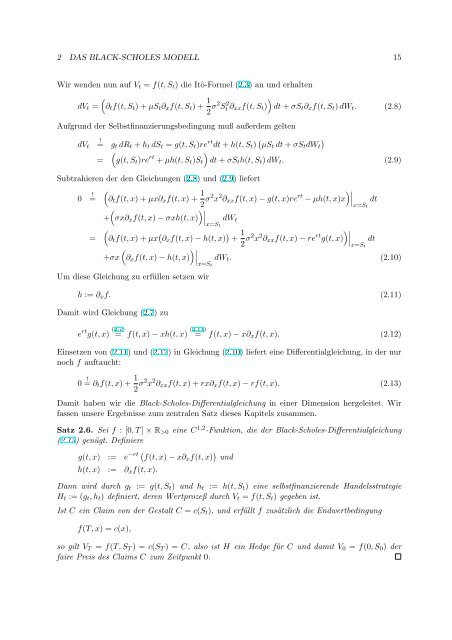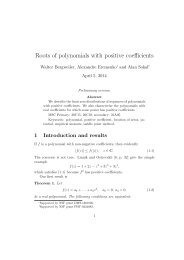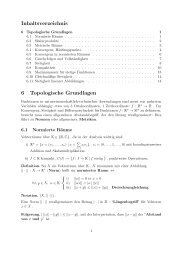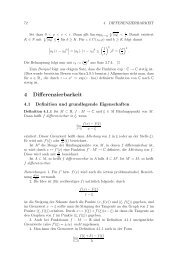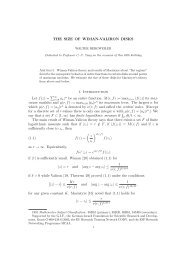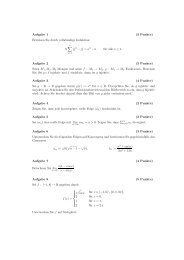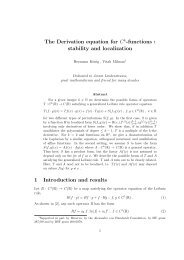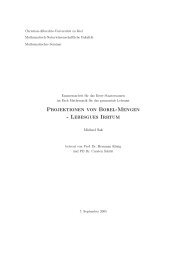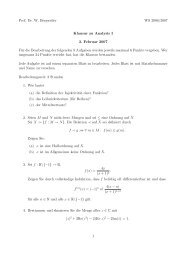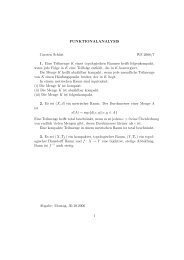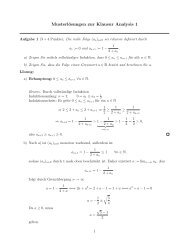Partielle Differentialgleichungen in der Finanzmathematik Vorlesung ...
Partielle Differentialgleichungen in der Finanzmathematik Vorlesung ...
Partielle Differentialgleichungen in der Finanzmathematik Vorlesung ...
Erfolgreiche ePaper selbst erstellen
Machen Sie aus Ihren PDF Publikationen ein blätterbares Flipbook mit unserer einzigartigen Google optimierten e-Paper Software.
2 DAS BLACK-SCHOLES MODELL 15Wir wenden nun auf V t = f(t, S t ) die Itô-Formel (2.3) an und erhaltendV t =(∂ t f(t, S t ) + µS t ∂ x f(t, S t ) + 1 )2 σ2 St 2 ∂ xx f(t, S t ) dt + σS t ∂ x f(t, S t ) dW t . (2.8)Aufgrund <strong>der</strong> Selbstf<strong>in</strong>anzierungsbed<strong>in</strong>gung muß außerdem geltendV t!= g t dR t + h t dS t = g(t, S t )re rt dt + h(t, S t ) ( )µS t dt + σS t dW t)=(g(t, S t )re rt + µh(t, S t )S t dt + σS t h(t, S t ) dW t . (2.9)Subtrahieren <strong>der</strong> den Gleichungen (2.8) und (2.9) liefert(!0 = ∂ t f(t, x) + µx∂ x f(t, x) + 1 2 σ2 x 2 ∂ xx f(t, x) − g(t, x)re rt ∣∣x=St− µh(t, x)x)∣dt(∣∣x=St+ σx∂ x f(t, x) − σxh(t, x))∣dW t(= ∂ t f(t, x) + µx ( ∂ x f(t, x) − h(t, x) ) + 1 2 σ2 x 2 ∂ xx f(t, x) − re rt ∣∣x=Stg(t, x))∣dt(∣∣x=St+σx ∂ x f(t, x) − h(t, x))∣dW t . (2.10)Um diese Gleichung zu erfüllen setzen wirh := ∂ x f. (2.11)Damit wird Gleichung (2.7) zue rt g(t, x) (2.7)= f(t, x) − xh(t, x) (2.11)= f(t, x) − x∂ x f(t, x). (2.12)E<strong>in</strong>setzen von (2.11) und (2.12) <strong>in</strong> Gleichung (2.10) liefert e<strong>in</strong>e Differentialgleichung, <strong>in</strong> <strong>der</strong> nurnoch f auftaucht:0 ! = ∂ t f(t, x) + 1 2 σ2 x 2 ∂ xx f(t, x) + rx∂ x f(t, x) − rf(t, x). (2.13)Damit haben wir die Black-Scholes-Differentialgleichung <strong>in</strong> e<strong>in</strong>er Dimension hergeleitet. Wirfassen unsere Ergebnisse zum zentralen Satz dieses Kapitels zusammen.Satz 2.6. Sei f : [0, T ] × R >0 e<strong>in</strong>e C 1,2 -Funktion, die <strong>der</strong> Black-Scholes-Differentialgleichung(2.13) genügt. Def<strong>in</strong>iereg(t, x) := e −rt ( f(t, x) − x∂ x f(t, x) ) undh(t, x) := ∂ x f(t, x).Dann wird durch g t := g(t, S t ) und h t := h(t, S t ) e<strong>in</strong>e selbstf<strong>in</strong>anzierende HandelsstrategieH t := (g t , h t ) def<strong>in</strong>iert, <strong>der</strong>en Wertprozeß durch V t = f(t, S t ) gegeben ist.Ist C e<strong>in</strong> Claim von <strong>der</strong> Gestalt C = c(S t ), und erfüllt f zusätzlich die Endwertbed<strong>in</strong>gungf(T, x) = c(x),so gilt V T = f(T, S T ) = c(S T ) = C, also ist H e<strong>in</strong> Hedge für C und damit V 0 = f(0, S 0 ) <strong>der</strong>faire Preis des Claims C zum Zeitpunkt 0.


